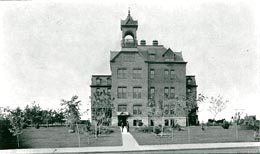On December 7, 1892, the Seventh Day Adventist Church opens Walla Walla College in College Place. In freezing temperature and in a building that is not quite finished, members of the college and the College Place communities gather for the inauguration of the college's vegetarian meal plan, a convocation service, and registration. After the service, 101 students register for primary, secondary, and basic college courses. More students will enroll, but institutional and national economic troubles will hamper the school in the coming years. In the early twentieth-century, Walla Walla College will emerge as a denominationally oriented liberal arts college. During the latter half of the century, the college will grow significantly and establish a number of successful professional programs. Because of its professional graduate programs, the school will change its name to Walla Walla University in 2007.
The Advent of the Adventists
The Seventh-day Adventist Church, which emerged out of a mid-nineteenth century apocalyptic movement, was established in 1863. Denominationally oriented education for all ages became an early priority for the denomination, and the church set up its first school in Battle Creek, Michigan, in 1872. As Adventism spread throughout the United States and beyond, Adventists established schools within their communities. Adventist missionaries reached California in the late 1860s and Adventist churches were organized in the Pacific Northwest in the 1870s. By the late 1880s, Adventists had established academies in Milton and Portland, Oregon.
During the 1890s, Adventists began expanding their educational programs at all levels. The denomination’s educational secretary, William Warren Prescott (1855-1944), visited the Northwest in 1890 and advocated for the consolidation of the schools in Milton and Portland into one large, centrally located institution. Walla Walla Mayor Nelson G. Blalock (1836-1913) offered the Adventists 40 acres of land a few miles west of the City of Walla Walla, and denominational leaders made a 25-year commitment to operate their school at the site.
A Place and a College
With $60,000 of support from the General Conference of Seventh-day Adventists and the citizens of Walla Walla, Walla Walla College began to take form. Land adjacent to Blalock’s donation was acquired, the town of College Place was named and platted, and lots were sold to migrating Adventists. Construction of the college building began in the spring of 1892 and college planners formed an administration, faculty, and curriculum. A date was picked and printed in the school’s catalog, and most of those living in College Place helped prepare for opening day. When opening day arrived, the college’s four-story brick building housed 80 students and nine members of the faculty.
Even though the building was not finished, the college opened on the predetermined date “without locks on the doors, with the kitchen unfinished, and without heat in the building” (Thurston, 102). After a breakfast of white crackers and milk, the school’s bell rang at 8:30 a.m. and people from the college and town assembled in the gymnasium in the basement of the building. The convocation service consisted of an opening prayer, a Bible reading, and remarks by college and church dignitaries. Registration followed and by the end of the day, 101 students had registered for primary, secondary, and basic college courses. The building was dedicated the following day, December 8, with a service in the chapel.
More students enrolled at the school, but tuition and gifts barely covered the college’s operating expenses. By the end of its first year, the college had run out of money and was unable to pay salaries. A severe economic depression followed and the school remained in debt for decades. But Walla Walla College continued to develop and in the early twentieth century it established itself as a denominationally oriented liberal arts college.
After World War II, the college started a number of successful professional programs in nursing, engineering, and marine biology. In 2007, to reflect its status as both an undergraduate and professional school, the school changed its name to Walla Walla University.

